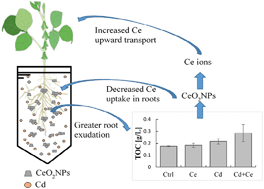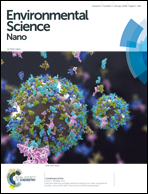Mutual effects and in planta accumulation of co-existing cerium oxide nanoparticles and cadmium in hydroponically grown soybean (Glycine max (L.) Merr.)†
Abstract
Cadmium (Cd) is a metal toxic to humans even at very low concentrations. Elevated levels of Cd in soil due to various anthropogenic activities have led to higher Cd concentrations in various crop tissues, making it a food safety concern. With the progressive production and continued accumulation of engineered nanoparticles (ENPs) in agricultural soils, understanding the effect of ENPs on the uptake and accumulation of metals by plants is imperative. The goal of this study was to determine the mutual effects of cerium oxide nanoparticles (CeO2NPs) and Cd2+ on their uptake and accumulation by soybean seedlings (Glycine max (L.) Merr.) in a hydroponic system. Soybean seedlings were exposed to four treatments (1.0 mg L−1 Cd2+, 1.0 mg L−1 Cd2+ + 100 mg L−1 CeO2NPs, 100 mg L−1 CeO2NPs and 0 mg L−1 Cd and CeO2NPs as the control) for 10 days. At termination, plant roots and shoots were separated and the concentrations of Cd and Ce in these tissues were determined. In addition, the amounts of ionic Ce and particulate Ce within soybean roots were determined. Significant interactions between co-existing CeO2NPs and Cd were found with regard to their accumulation in plant tissues. While CeO2NPs did not affect the total Cd associated with soybean roots, they significantly reduced the translocation of Cd from roots to shoots by 70%. In contrast, the co-presence of Cd lowered the concentration of Ce in soybean roots by 45% but significantly increased the concentration of Ce in soybean shoots by 60%. The altered plant accumulation of co-existing Cd and Ce was attributed to various physical, chemical and biological processes that occurred in the plant rhizosphere. Specifically, the co-presence of Cd and CeO2NPs led to higher excretion of plant root exudates, which might have altered the chemical environment in the plant rhizosphere and enhanced CeO2NP dissolution, leading to different plant accumulation of both chemicals.



 Please wait while we load your content...
Please wait while we load your content...